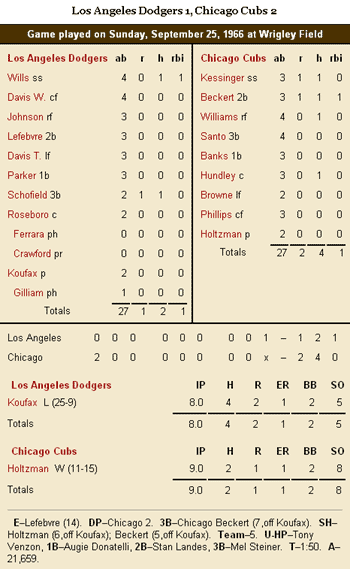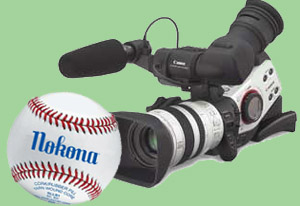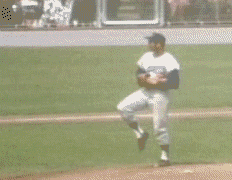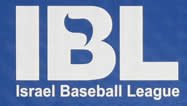I just watched the Phillies pitcher Cole Hamels throw a gem. He pitched eight innings giving up two hits while striking out eleven and walking only one. He is the National League version of John Santana, a southpaw with an above average fastball and a devastating changeup.
I recently spoke to a group of High School pitchers and said that the changeup is a better pitch than a curve. As I said it I realized it is not really accurate in the absolute sense but I let the statement stand in order to emphasize its value in light of its underappreciated status in the amateur ranks.

Some of the greatest pitchers currently playing have staked the claim of greatness on their changeup. I classify the splitter in the same category as the other traditional changeups such as the circle, palm, fosh etc. The bottom line is that the change of speed is the key deceptive element of those pitches, its movement, though integral to its effectiveness, is secondary to its change of pace. Some of the currently playing greats who rely heavily on their changeups are Cy Young winners Johan Santana, Tom Glavine, Gregg Maddux, Pedro Martinez, Roger Clemens (splitter), and on the relief side, Future Hall of Famer, Trevor Hoffman. This of course is an abbreviated list but just looking at those names is impressive. Interestingly, Barry Zito, known for having among the best curveballs in the game, threw more changeups than curves last year.

With the changeup being responsible for so much pitching success, I have been thinking about why the changeup is so undervalued outside the professional leagues. This is what I came up with. Kids (think 12 and under) love to make balls curve, it is magical and hence irresistible. Additionally, making the ball curve will almost always leave a batter who, is uninitiated to the wily ways of the breaking ball, look utterly hapless. Changeups, on the other hand, are not magical on the surface. The magic is unveiled when you are facing a hitter that can crush your best fastball and swings with futility ahead of a pitch that plods through the strike zone at the pace of tractor on the autobahn.
There are other reason little leaguers put the changeup on the back burner. For the changeup to be effective a pitcher needs to establish a fastball. Often little leaguers simply don’t have enough velocity on their fastball to make the change of pace on their changeup effective. Changeups are also counter intuitive for young pitchers. Pitchers learn early that most often the harder they throw the better the results. So asking them to throw a change up, which is essentially a batting practice pitch, is scary. This leap of faith comes with experience and maturity.
The above reasons make sense, but I still believe coaches should teach kids the changeup before the curve. One reason to teach kids to throw a changeup before a breaking ball is health. The American Sports Medicine Institute recommends that kids should be 14 years old (give or take two years) before they start throwing curveballs. Aside from health reasons, the changeup expedites the process of teaching kids to be pitchers rather than throwers. Hall of Fame pitcher, Warren Spahn, said that “Hitting is timing. Pitching is upsetting timing.” the change up brings that point home. So first learn to throw the fastball with proper mechanics and control, and then learn the changeup.


 Some of the greatest pitchers currently playing have staked the claim of greatness on their changeup. I classify the splitter in the same category as the other traditional changeups such as the circle, palm, fosh etc. The bottom line is that the change of speed is the key deceptive element of those pitches, its movement, though integral to its effectiveness, is secondary to its change of pace. Some of the currently playing greats who rely heavily on their changeups are Cy Young winners Johan Santana, Tom Glavine, Gregg Maddux, Pedro Martinez, Roger Clemens (splitter), and on the relief side, Future Hall of Famer, Trevor Hoffman. This of course is an abbreviated list but just looking at those names is impressive. Interestingly, Barry Zito, known for having among the best curveballs in the game, threw more changeups than curves last year.
Some of the greatest pitchers currently playing have staked the claim of greatness on their changeup. I classify the splitter in the same category as the other traditional changeups such as the circle, palm, fosh etc. The bottom line is that the change of speed is the key deceptive element of those pitches, its movement, though integral to its effectiveness, is secondary to its change of pace. Some of the currently playing greats who rely heavily on their changeups are Cy Young winners Johan Santana, Tom Glavine, Gregg Maddux, Pedro Martinez, Roger Clemens (splitter), and on the relief side, Future Hall of Famer, Trevor Hoffman. This of course is an abbreviated list but just looking at those names is impressive. Interestingly, Barry Zito, known for having among the best curveballs in the game, threw more changeups than curves last year. With the changeup being responsible for so much pitching success, I have been thinking about why the changeup is so undervalued outside the professional leagues. This is what I came up with. Kids (think 12 and under) love to make balls curve, it is magical and hence irresistible. Additionally, making the ball curve will almost always leave a batter who, is uninitiated to the wily ways of the breaking ball, look utterly hapless. Changeups, on the other hand, are not magical on the surface. The magic is unveiled when you are facing a hitter that can crush your best fastball and swings with futility ahead of a pitch that plods through the strike zone at the pace of tractor on the autobahn.
With the changeup being responsible for so much pitching success, I have been thinking about why the changeup is so undervalued outside the professional leagues. This is what I came up with. Kids (think 12 and under) love to make balls curve, it is magical and hence irresistible. Additionally, making the ball curve will almost always leave a batter who, is uninitiated to the wily ways of the breaking ball, look utterly hapless. Changeups, on the other hand, are not magical on the surface. The magic is unveiled when you are facing a hitter that can crush your best fastball and swings with futility ahead of a pitch that plods through the strike zone at the pace of tractor on the autobahn.




